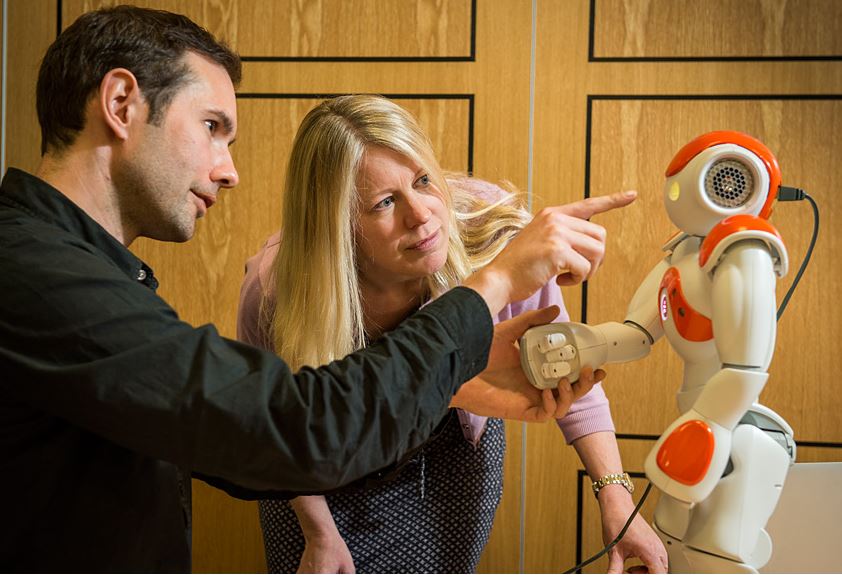If you can’t be at a business meeting, using NAO as your robot avatar instead of a simple video-conferencing or a Skype-like service is much more effective for successful business negotiations. NAO shakes hands and makes the negotiation participants more inclined to cooperate and trust each other.
In computing, an avatar is the graphical representation of the user. In robotics, it is his or her physical representation, i.e. a robot that represents you.
This is what researchers who work in the University of Bath’s Department of Psychology say, after carrying out several experiments using the humanoid robot as an avatar for somebody who could be sitting thousands of miles away.
![]()
The findings from this study could revolutionise how robots are used in business negotiations. (Image: Nic Delves-Broughton, University of Bath)
NAO is more effective than Skype
Using a humanoid robot avatar provides an effective two-way experience that allows the participants to experience the physical presence of each other, even though they are not.
This feeling of being with the other negotiator beats a Skype-like video-conferencing service, the researchers said.
Developing such interactions, including handshakes, through your avatar should eventually lead to robots conducting business meetings, or allowing people with mobility difficulties being able to interact with the outside world in an extremely effective and unique way.
NAO is a 23-inch (58cm) tall humanoid, programmable robot developed by Aldebaran Robotics, a Paris-based company specialised in making and marketing humanoid and programmable robots.
NAO came onto the public market in 2008. The robot is extremely popular in academic institutions, used for research purposes. Currently, over 5,000 NAO units are being used in more than fifty nations.
Mock property deal negotiations with NAO
Professor Danaë Stanton Fraser and Dr. Chris Bevan carried out experiments using the humanoid robot in pretend real estate negotiations.

Dr Chris Bevan and Professor Danaë Stanton Fraser in the lab with the humanoid robot NAO. (Image: University of Bath)
One participant – who acted as either buyer or seller – physically entered the business meeting room and was presented with NAO, while the other participant attended the meeting through his or her robot. NAO, with an inbuilt microphone and head camera, was the remote person’s avatar.
When NAO shakes hands, it sends a signal to a device in the remote person’s hand that vibrates. This occurs because the robot has sensors on its hands which respond to touch.
The research team found that the simple act of a handshake was as crucial when people negotiated virtually through the avatar as when they met face-to-face physically.
They also found that the person interacting through his or her avatar, who could be sitting in the other side of the world, did not exploit their technical advantage in such circumstances.
Handshaking vital for fostering cooperation and trust
Dr. Bevan, who works as a Research Associate in the Department of Psychology, and is currently attached to the EPSRC (Engineering and Physical Sciences Research Council) funded project ‘Being There: Humans and Robots in Public Spaces’ (2013-2016), said:
“This experiment highlights just how important the symbolic ritual of shaking hands is upon the way people come to judge others as being trustworthy and willing to cooperate.”
“Using a robotic avatar, we were able to demonstrate that this effect holds true even when a person cannot see the face of their counterpart.”
The study focused on how handshaking might affect many levels of cooperation and trustworthiness, as well as the negotiator’s willingness to be misled on purpose.
A total of 120 volunteers took part in the mock negotiations. They were randomly selected to be either the buyer or seller, in a property deal scenario involving between £24 million and £42 million ($38m and $66m).
One of the negotiators interacted through a NAO-avatar. The person who was not physically present shook hands through NAO, even though the two people were not together in the same room.
When the participant who was in the room shook hands with the robot, there was a feeling of being physically connected and close to the other person. The avatar user, through the vibrations felt in his or her hand, experienced the same sensation.
Prof. Stanton Fraser, who specialises in Human Computer Interaction and is head of the University’s CREATE Lab, which researches into the design and evaluation of mobile and ubiquitous technologies, said:
“The formation of interpersonal trust and cooperation are key to future success of computer supported cooperative work, yet the availability of many of the social cues we rely upon when interacting one-to-one are often restricted in these scenarios.”
“These findings underline the significance of touch and the simple gesture of a handshake, and will be important as we work to further develop robot systems with valuable applications across society.”
The participant who was in the meeting room could hear the avatar user through NAO’s built-in speakers, but could not physically see the other person.
Several different types of mock-negotiation experiments were done – with and without handshakes, and with and without vibrations.
Reference: Danaë Stanton Fraser. “Shaking Hands and Cooperation in Tele-present Human-Robot Negotiation.” HRI ’15 Proceedings of the Tenth Annual ACM/IEEE International Conference on Human-Robot Interaction. Pages 247-254. ISBN: 978-1-4503-2883-8. DOI: 10.1145/2696454.2696490.
Video – NAO has several different uses
